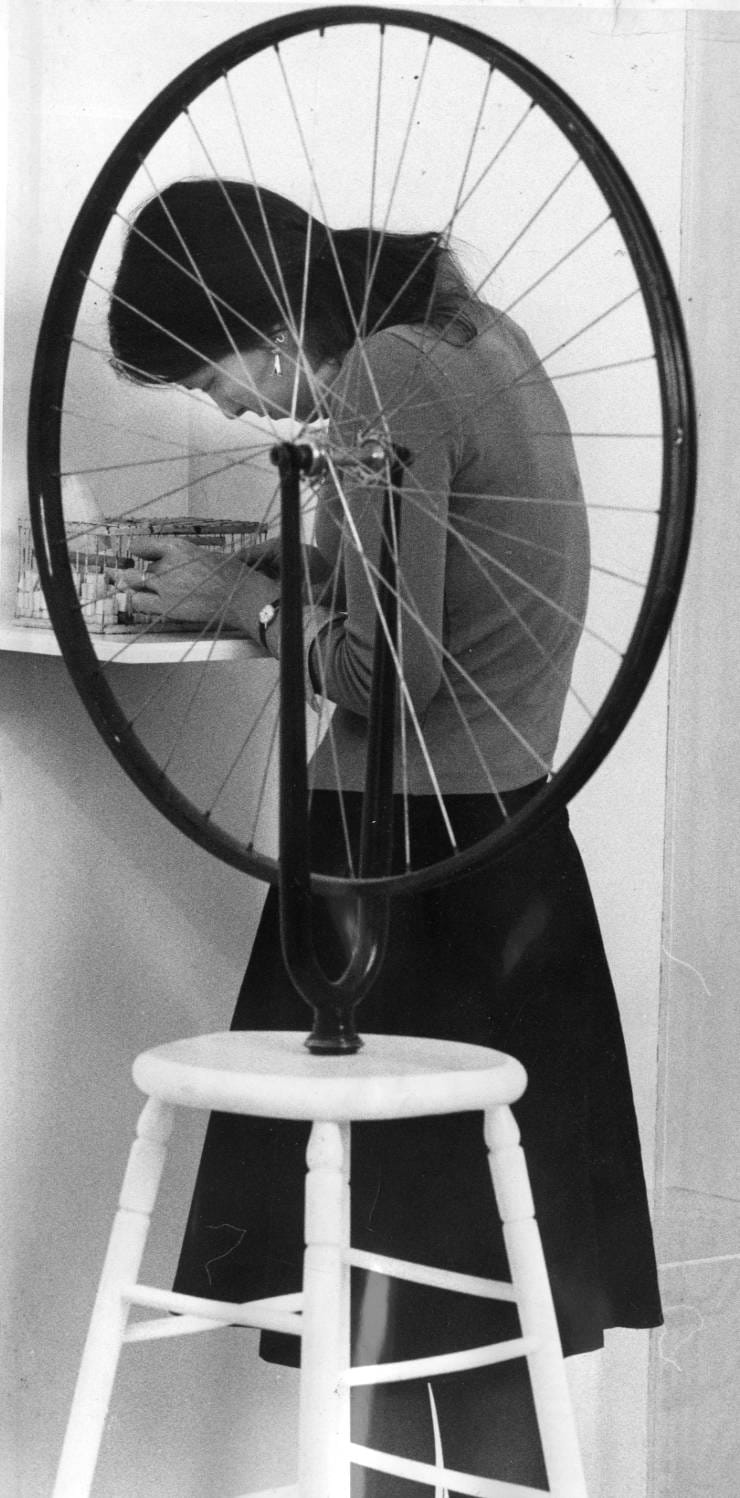Pedaling Through Time in Philadelphia
Images of biking in Philadelphia from the past century, collected in Temple University archives, illustrate the enduring joy, utility, and tension in cycling, and can guide advocacy in the future.
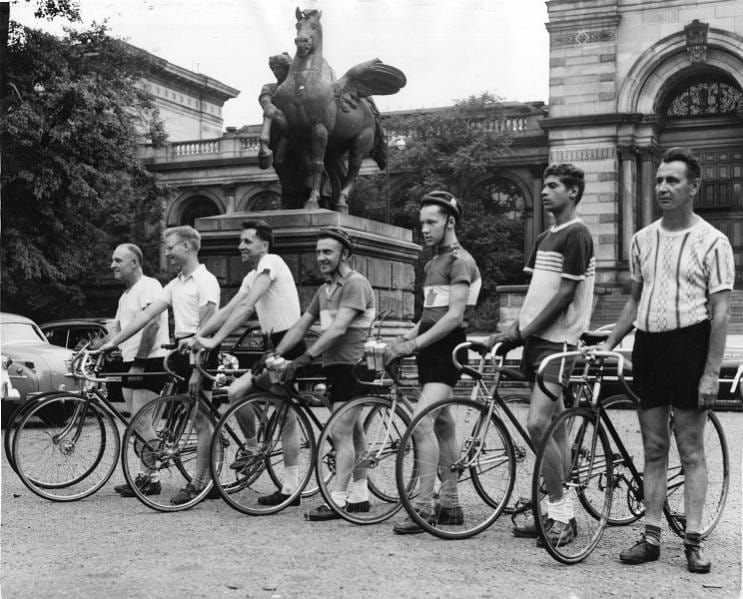
Recent talks of a strike by Transport Workers Union members reminded me of photos I'd studied from decades past of Philadelphians using bikes during transit strikes. I'd analyzed these photos, among others highlighting the role of bikes in Philadelphia, for an essay in Professor Francesca Ammon's Photography and the City class in early 2023 at the University of Pennsylvania (a class that played a sizable role in inspiring the development of The Trellis). Despite its more academic tone, I hope you'll enjoy that essay featured here.
I also graciously invite you to use the search tool at this link to get lost in the treasure trove of historic photos found in the repository I drew upon for this essay. Simply type in 'bikes,' 'bicycle,' 'giraffe,' or any other term that interests you.
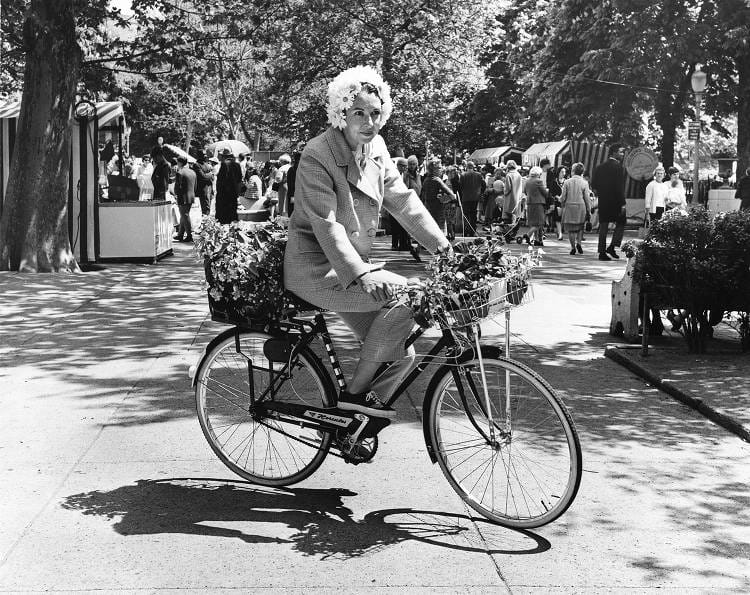
Introduction
Philadelphia has maintained a rich biking culture for as long as the bicycle has existed. Throughout that time, Philadelphians have used bicycles to play, relax, commute, compete, or simply to help them accomplish their daily tasks. Photos captured across the decades show us that, despite how much the world has changed, bikes have played a consistent role in the city and in the lives of its inhabitants. Using photos to look into the eyes of past cyclists shows us how riders past and present have all known the joy, utility, and tension of riding a bike in Philadelphia. Images of biking in Philadelphia from the past, such as those found in the George D. McDowell Collection at the Charles Library of Temple University, can be used to highlight the bicycle’s many merits and to advocate for biking in Philadelphia in the future.
The George D. McDowell Collection at the Charles Library of Temple University is a meticulously managed archive of images from the Philadelphia Evening Bulletin that contains, among a treasure trove of other things, dozens of images in a variety of categories of cycling in Philadelphia. The collection includes boxes of photographs with their original dates and descriptions and is divided into categories such as ‘Antique Bicycles,’ ‘Bicycles Misc, 1930 to 1939 (and other chronological sets),’ ‘Bicycle Races,’ ‘Bicycle Repairs,’ and ‘Bicycle Accidents.’ The collection is also easily sorted and viewed through an online database.
The Philadelphia Evening Bulletin was created in 1847 under the name Cummings’ Evening Telegraphic Bulletin and by 1915 was the top ranked of Philadelphia’s 13 daily papers. Although it remained family-run through the 1970s, changing times and increased competition resulted in the paper’s demise in January 1982.¹ For the purposes of this essay, a small sample of images have been selected to embody three qualities of urban cycling: joy, utility, tension.
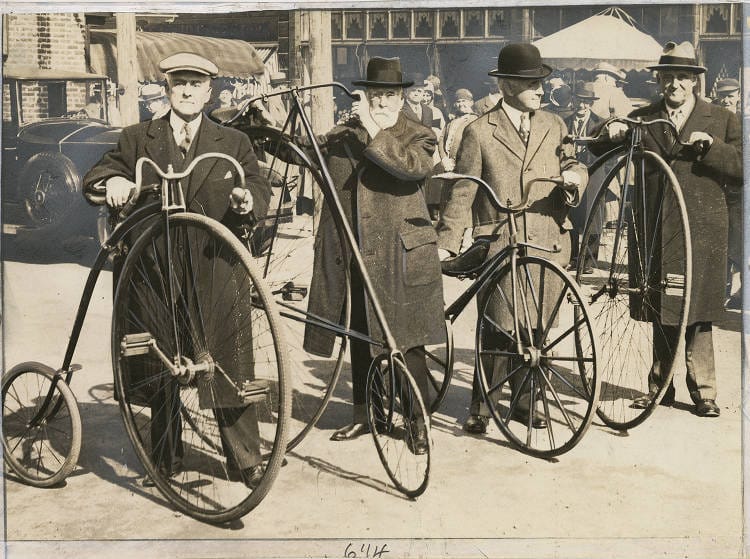
Joy
As bicycles proliferated in the late nineteenth century, so too did the ways that they were used. Bicycles of all shapes and sizes could be used in all different ways – from a practical tool for mobility, to a tool for recreation or for competition. From the very beginning, an important part of the bicycle has been its power to induce joy in its users.
The celebration of the 55th anniversary of the bicycle in America, shown in 1931 in Image 1, illustrates the variety of bicycles that one could encounter in a city at the turn of the twentieth century. Though manufacturing standards have evolved and refined since this photo was taken, one would not be surprised to see a similar variety of wheel, frame, or handlebar designs at a modern celebration of the bike like at the annual Philadelphia Bike Expo.
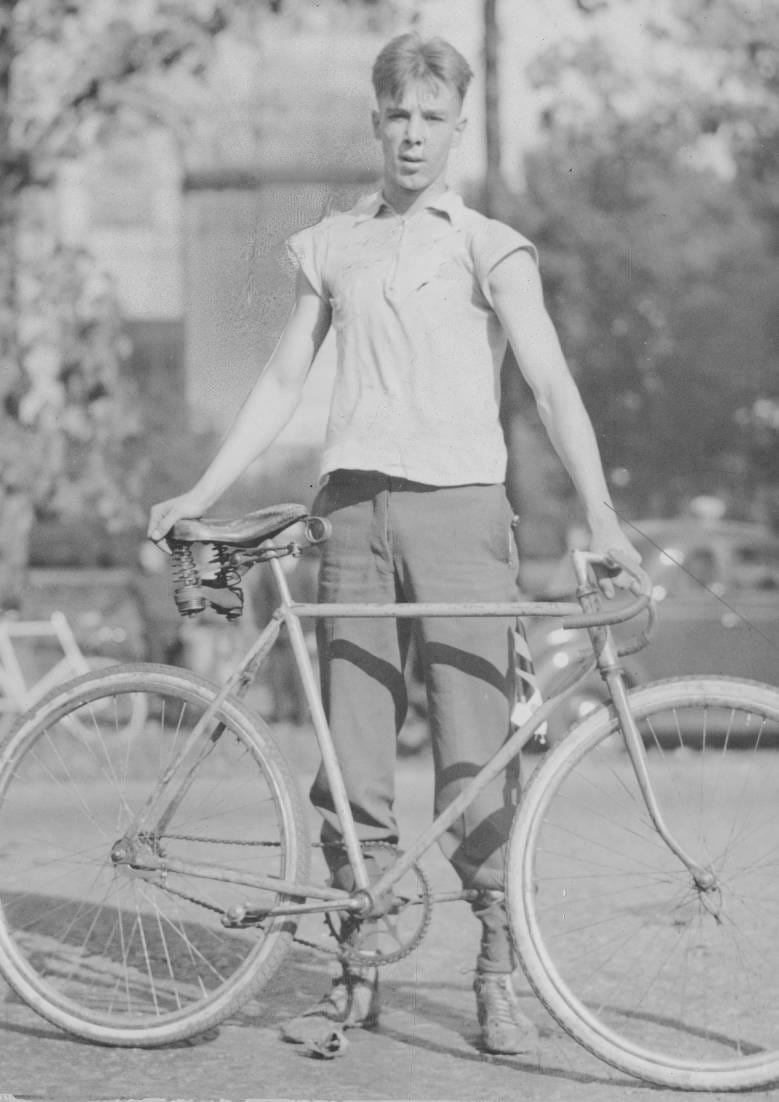
Image 2 depicts William Seegar, winner of a bicycle race held in West Fairmount Park in 1935, the first of its kind held since 1890. Despite an evolution of cycling fashion since the Dirty Thirties, the rider’s pose with his winning machine would feel familiar to anyone who follows modern bicycle racing. At the same time, Philadelphians who remember the Manayunk bike race, which ran from 1985 to 2016², may relate to the ephemeral nature of bicycle racing in their city. Compared with Dorothea Lange’s photograph Migrant Mother from 1936, depicting a contemplative mother of seven in depression-era California, these pictures strike a much more upbeat tone despite what we know to have been a nation-wide social and economic disaster.
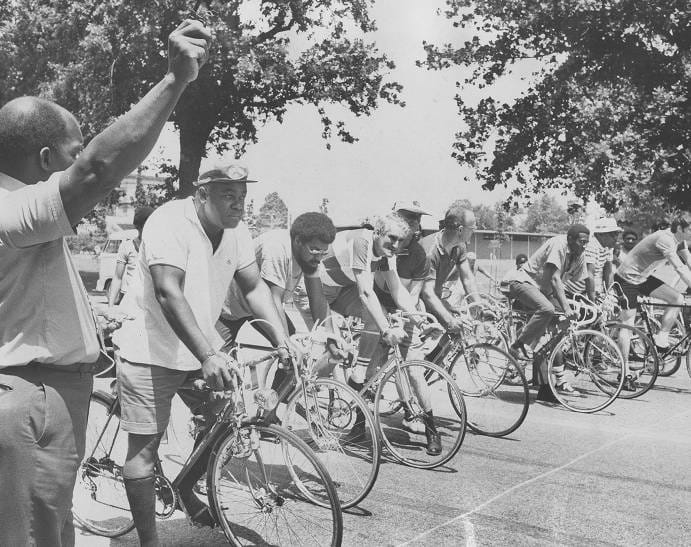
Bicycle racing continued as a form of recreation and competition in Philadelphia, and Image 3 depicts a starting line with a mix of Black and white cyclists in the men’s 26 and over division in 1970. While modern viewers don’t think twice about racially integrated race fields today, it is important to emphasize that that was not always the case. While in June of 1900 the Philadelphia Inquirer reported positively of a group of Black cyclists who rode 100 miles from New York to Fairmount Park,³ one cannot ignore that Black people were denied or revoked membership from the League of American Wheelmen (modern League of American Bicyclists) beginning in 1894⁴ until that condition was officially revoked in 1999.⁵ Bicycle racing has remained a compelling recreational outlet while welcoming a more diverse set of riders over the years, but even today transgender and non-binary athletes are continuing the fight for recognition and acceptance that started generations ago.
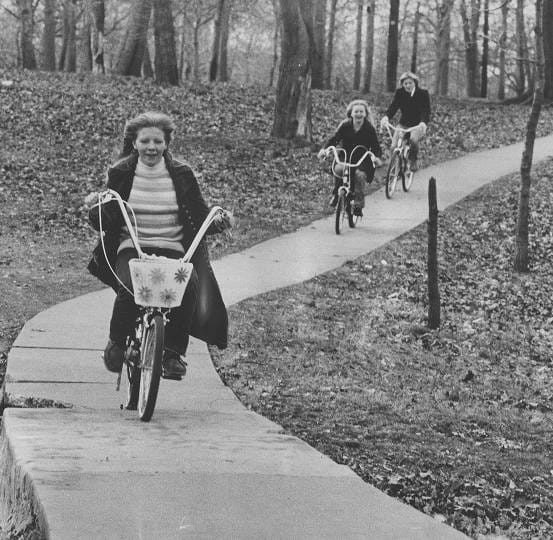
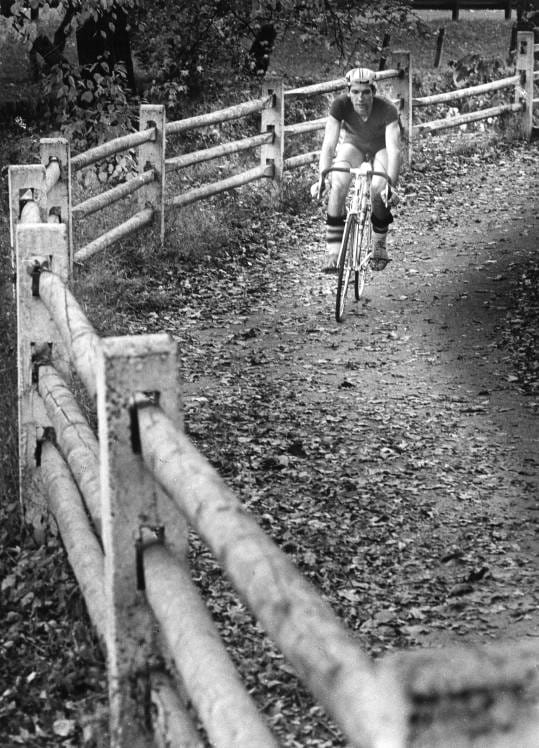
Left: Image 4. "The Muller sisters, (front to back) Pat, 14, Diane, 17, and Mary, 18, enjoy brisk but sunny weather in Wissinoming Park, in Northeast." (McLaughlin, Joseph. “Sisters biking in Wissinoming Park” March 3, 1975. George D. McDowell Philadelphia Evening Bulletin Collection.) Right: Image 5. "Cyclist stays close to nature on an isolated bike path along Wissahickon Creek in Fairmount Park." (McLaughlin, Joseph. “Cyclist in Fairmount Park” November 24, 1981. George D. McDowell Philadelphia Evening Bulletin Collection.)
Outside of formal events, Philadelphians have long taken to the city’s sprawling park system to enjoy the feeling of the wind in their hair or the smell of crushed leaves along the city’s rivers and streams. While Image 4 depicts a trio of teenage sisters pedaling through a park in Northeast Philadelphia and Image 5 shows a lone man teeming along a trail in Northwest Philadelphia, the striking compositional similarity between the photos suggests that the joy these people are experiencing is mutual and serves as an invitation to past and present viewers to ride around their nearest park. Image 6, part of a series of images of the same girls on a ‘bike hike’ to Morris Park in West Philadelphia, illustrates how bicycles have long been used to escape the mundane and to participate with friends in outdoor recreation. Not only did bikes provide freedom from Philadelphia’s dense and dirty downtown, they served as a tool to emancipate women from enduring social expectations dictating how they should behave, dress, or interact with space in the city.⁶
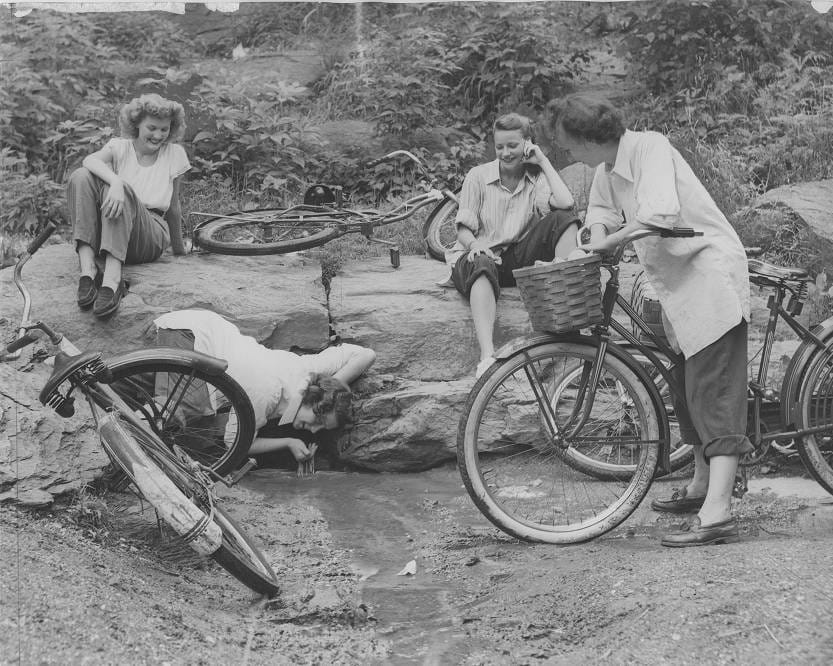
Utility
More than for just a good time, Philadelphians have long embraced the bicycle as a convenient and inexpensive mode of transportation. In its early days, a bicycle was more accessible and far less expensive than a horse. Later, as trolleys tracks spread throughout the city, the bicycle allowed users to take more direct routes at more flexible times. Even as the automobile gained in popularity, bicycles have remained almost universally accessible and have provided healthy and sustainable access to resources for individuals and families of all backgrounds.
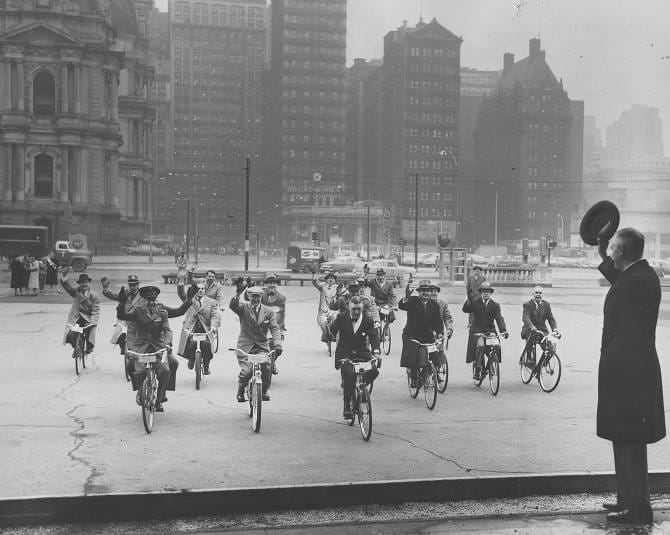
Image 7 shows Mayor Richardson Dilworth welcoming a group of cyclists sponsored by the Heart Association of Southeastern Pennsylvania to demonstrate the health benefits of cycling. No other transportation system has had the potential to make such a positive impact on public health as riding a bike. Including the mayor in any photo sends a powerful message and this monumental photograph is a powerful endorsement for the utility of the bicycle as a tool for wellness that rings true today as it did in 1957. Much of the imagery we saw in class of politicians during the era of urban renewal highlighted the ‘modernization’ of the city, often by destruction of the old. This photo stands out in opposition of that precedent.
Image
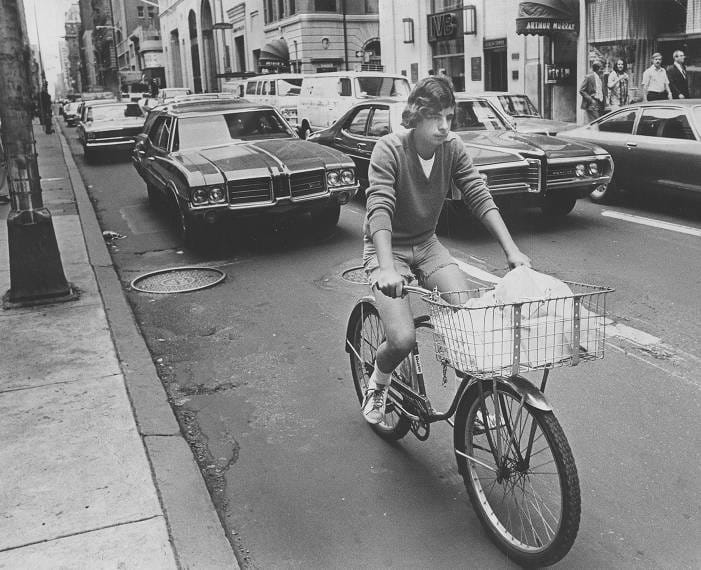
Image 8 highlights the activities of a bicycle messenger, an important but typically invisible actor in American cities. Bicycle messengers like the one in this image deliver packages, healthcare material, and other goods and can navigate the city quickly and nimbly despite heavy traffic. The caption points out the added bonus that this bicycle consumes no fuel. The amount of space this ‘delivery vehicle’ consumes compared to the cars surrounding it makes a compelling case for the utility of the bike amidst ever-present and ever-frustrating congestion. As Julia Foulkes points out in To the City: Urban Photographs of the New Deal, “the automobile became a defining element of American life,”⁷ despite recently having simply been only ‘notable objects’ in the backgrounds of photos like in this essay’s Image 1.
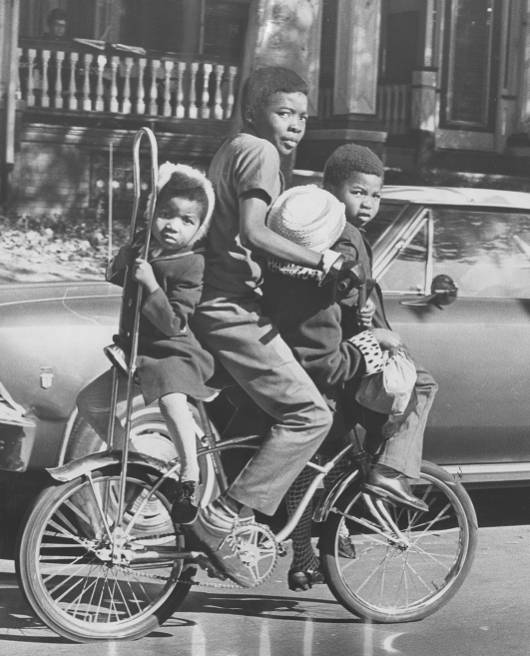
Four children making their way through West Philadelphia on a single bike is one of the more compelling images in this archive. Surely, these youngsters are getting the maximum value out of a singular resource. The photo recalls more questions than answers: Who are they? Where are they going? Is this how they get everywhere? Why was this image captured? Why are they looking backwards toward the camera? Furthermore, it’s hard to imagine if this is a typical scene in that time or place, as it would be such an unusual sight today. It conjures street photography from Diane Arbus, whose Exasperated Boy with Toy Hand Grenade⁸ from the same decade elicits similar curiosity. Was the Bulletin photographer inspired by contemporaneous street photography or by Arbus herself? Seeking an explanation, my mind runs flat like the back tire of the bike in the photo. Modern advocates, however, should rejoice in witnessing the utility that the humble bicycle has provided for so many for so long.
Tension
For all the joy and utility inherent in cycling in Philadelphia, a tension has always been present as well. Since their introduction in the late nineteenth century, bicycles and their riders have always competed for space and infrastructure with other modes such as horses, trolleys, automobiles, and pedestrians. Alas, planners of the early to mid-twentieth century embraced the automobile at the expense of other modes and as a result we have suffered the consequences of congestion and pollution. All the while, the most vulnerable road users have witnessed violence, adapted to conditions, and organized for action.
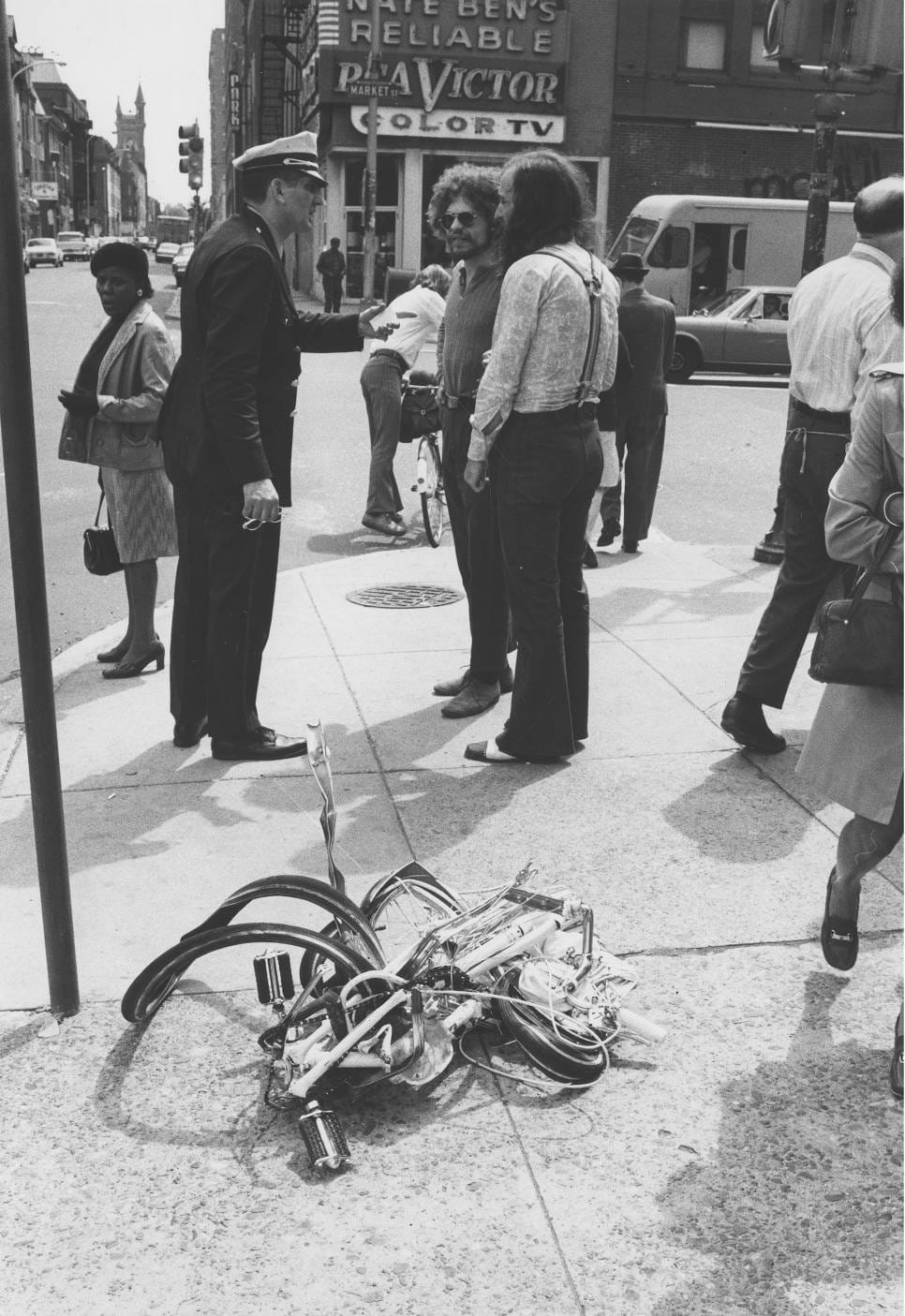
An article published in May 1971 contains a series of photos, including Image 10, showing the aftermath of a collision between a girl on a bicycle and a large trailer-truck hauling liquid argon. The captions fall just short of accusing the girl of taking on the truck and show no signs of sympathy or compassion. Image 10 and its partners are of the most disturbing in the archive, perhaps because incidents like this continue to maim pedestrians and cyclists today, over 50 years later. Activists in Philadelphia today will be familiar with ‘Ghost Bicycles’ placed to mark the place where a cyclist lost their life in a collision. On the other hand, activists in Philadelphia will rejoice to know that at 21st and Market Streets, where this image was captured, a new two-way parking separated bike lane has recently been installed and will soon offer safer passage to bike riders of all ages and abilities.
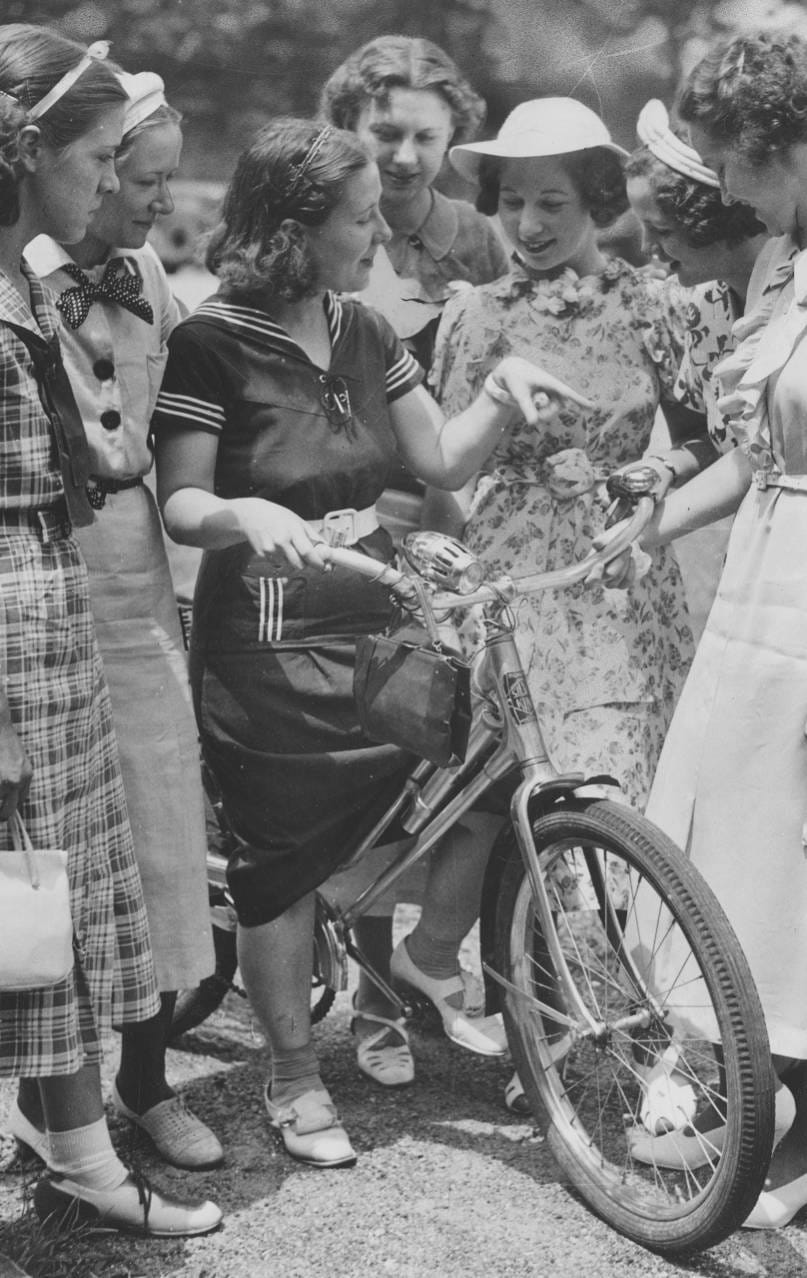
What appears at first glance to be a glamour shot of young women dressed in their Sunday best is actually the product of what today seems the most absurd occasion. Though it looks like these women gather around to inspect a new ring on the finger of the woman in the black dress, they are actually inspecting her bicycle bell! The photo’s caption explains that 40 cyclists were arrested by Fairmount Park Police for not having bells on their bikes! Modern cyclists who complain of the tension of cars parked in the bike lane will appreciate that they should not expect to be harassed by police for whether they have bells or even helmets, though we might agree they are quite useful appliances.
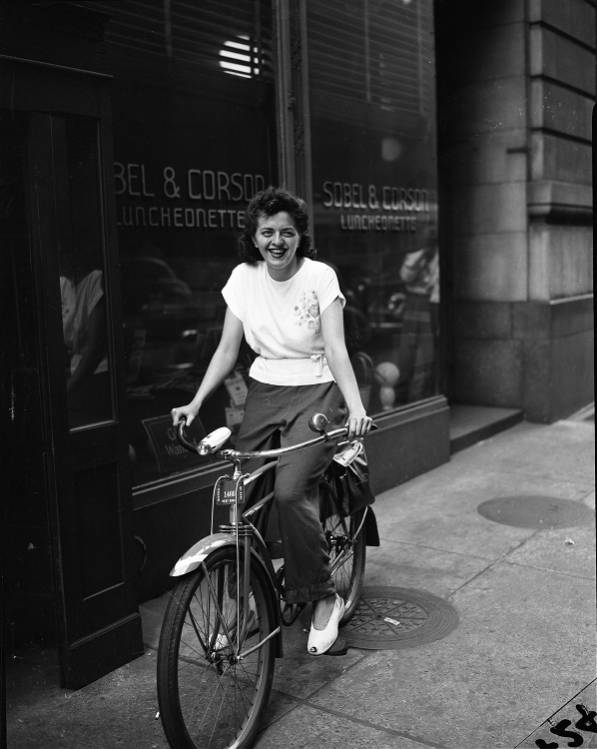
All Philadelphians can relate in a common ambivalence towards the city’s public transportation service. At best, it always feels like it should be a little faster or a little cleaner! This is true for Philadelphians in 2023 as it was four decades ago in 1981 (Image 13) or four decades before that in 1944 (Image 12), whether the service was SEPTA (Southeastern Pennsylvania Transportation Authority) or P.T.C. (Philadelphia Transportation Company). Though the woman in Image 12 appears far happier about it than the man and his dog in Image 13, both subjects were able to rely on their bikes during city-wide transportation tension resulting from transit strikes.
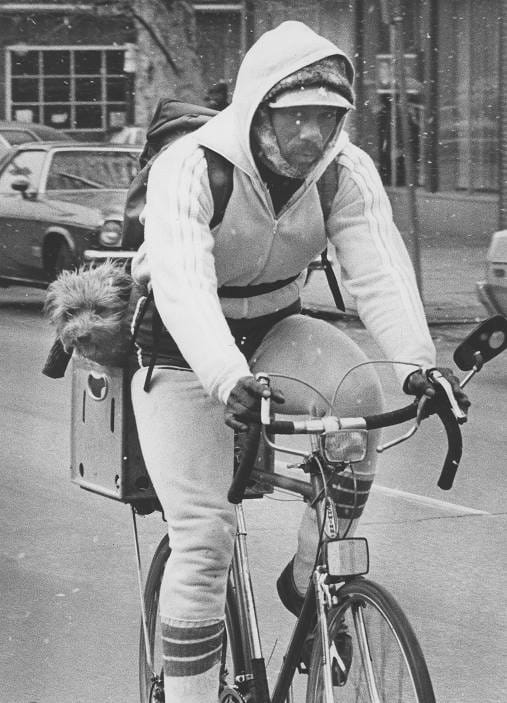
Like transit operators striking for improved conditions, cyclists have organized for resources as well. In Image 14, a number of cyclists apply pressure outside of Philadelphia City Hall demanding expanded bike routes and bike parking facilities. The tension experienced by those adapting during transit strikes or asking for safer bicycle infrastructure feel woefully relatable today. In these photos and in modern photos, the people look the same, the street designs look the same, and the tensions feel the same, despite all that has occurred in the intervening decades.
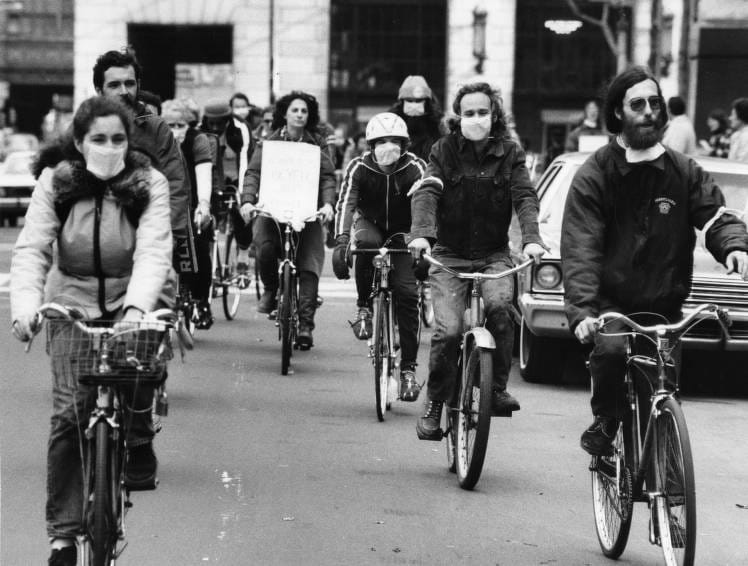
Summary
The images presented in this essay transcend time and show us the enduring joy, utility, and tension inherent to cycling in Philadelphia. Bicycles have been celebrated in Philadelphia since their earliest days as beautiful machines capable of propelling their riders to great speeds or to far-away places. People
of all ages, genders, and skin colors enjoyed the freedom provided by bikes to spend quality time with friends and to enjoy the great outdoors. While it is almost always fun to ride a bike, it is also a tool of great utility. The act of using it improves the rider’s health, whether they are running errands, transporting goods, or simply evading traffic jams. A well-balanced bike can even handle multiple passengers! Of course, there has always been a tension inherent in operating a bike in the city. Bikes are vulnerable to cars and their drivers and cyclists have been seriously injured or killed by the hundreds in this city over time. Rules and regulations have only made it more difficult for people to embrace the joy and utility of using a bike, but transit strikes and the inflation of fuel prices have enticed more people to adopt pedal power. The omnipresent tension has inspired protests for expanded and improved access across Philadelphia.
Despite all of the changes that have occurred in the world in the 90 years since the first photo in this essay was taken, each of these photographs feels familiar and relatable. Contemporary cyclists in Philadelphia will be able to relate to the joy of seeing new bike technology or watching or participating in a race. They will know the feeling of spending time in the park with friends. They will also understand the health benefits and the time savings of riding past traffic jams. They will know the feeling of reading the latest news of a cyclist hit by a car and they will be ready to protest injustice. These familiar images evoke familiar feelings and that will not soon change. As such, images of biking in Philadelphia from the past, such as those found in the George D. McDowell Collection at the Charles Library of Temple University, can be used to highlight the bicycle’s many merits and to advocate for biking in Philadelphia in the future.
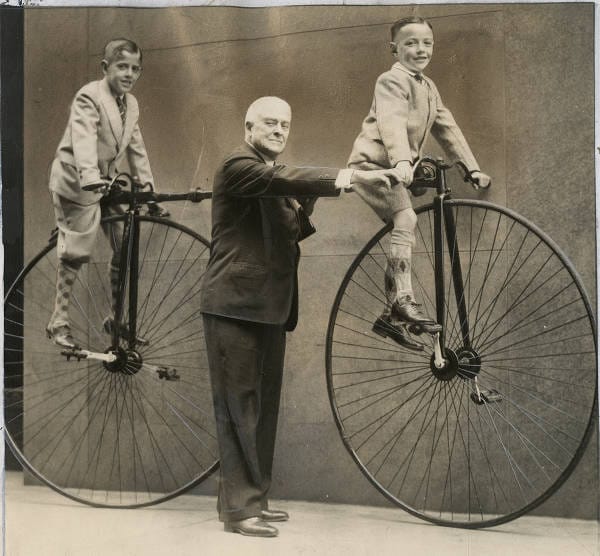
References
All photos courtesy of the Special Collections Research Center. Temple University Libraries. Philadelphia, PA.
- Wyatt, Jay. “Nearly Everybody Read the Bulletin.” The PhillyHistory Blog, August 24, 2006, https://blog.phillyhistory.org/index.php/2006/08/nearly-everybody-read-the-bulletin/
- Ben-Yaacov, Shai. “Is it the end of the road for the Manayunk bike race?” WHYY, February 26, 2018, https://whyy.org/articles/end-road-manayunk-bike-race/
- Friss, Evan. The Cycling City: Bicycles & Urban America in the 1890s (Chicago and London: The University of Chicago Press, 2015), 60.
- Friss, Evan. The Cycling City: Bicycles & Urban America in the 1890s (Chicago and London: The University of Chicago Press, 2015), 58.
- “Equity and Our History.” The League of American Bicyclists, n.d. https://bikeleague.org/about/equity-and-history/
- Friss, Evan. The Cycling City: Bicycles & Urban America in the 1890s (Chicago and London: The University of Chicago Press, 2015), 160-163.
- Foulkes, Julia. To the City: Urban Photographs of the New Deal. (Philadelphia: Temple University Press, 2011), 34.
- Meister, Sarah Hermanson. Arbus, Friedlander, Winogrand: New Documents, 1967 (New York: Museum of Modern Art, 2017) 62.
